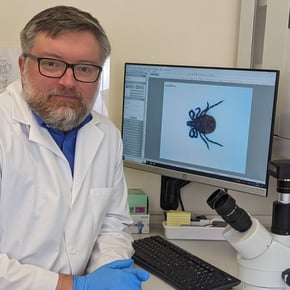
Do ticks die when it's cold outside? Many think yes, but Paul Killinger of of TickReport has data that says otherwise.
Originally published on Medzulabs.org
It’s commonly thought that ticks and other tiny biting creatures die off over the winter, but that myth doesn’t explain how there are so many the following year! In reality, ticks as a population are fairly skilled at reading the signs and taking steps to stay warm and hydrated during those cold months. This energy-conserving decision to suspend questing may be called Behavioral Diapause.
How cold is too cold for ticks?
 Most experts look at 4 degrees Celsius or 40 degrees Fahrenheit as a common tipping point between questing and resting weather for common human-biting Ixodes ticks like the Deer tick, Western black-legged tick, or Castor Bean tick. Ticks from other genera like the American dog tick (Dermacentor variabilis) and Lone star tick (Amblyomma americanum) tend to get out of the cold at higher temperatures earlier in the year.
Most experts look at 4 degrees Celsius or 40 degrees Fahrenheit as a common tipping point between questing and resting weather for common human-biting Ixodes ticks like the Deer tick, Western black-legged tick, or Castor Bean tick. Ticks from other genera like the American dog tick (Dermacentor variabilis) and Lone star tick (Amblyomma americanum) tend to get out of the cold at higher temperatures earlier in the year.
It’s important to remember that this 4C/40F point isn’t a hard line that will automatically send all ticks scurrying for leaf litter. Instead, it is a rough temperature at which, all other conditions (humidity, wind, etc.) being equal, most Ixodes ticks will decide that the risk of expending energy and hydration is no longer worth the possible reward of finding and feeding on a host. They will return to the insulating microclimate of leaf litter and other materials covering the ground and wait for better weather to resume questing. Individual ticks may still try to find a host at lower temperatures, but they will be fewer and farther between. Their cold-weather gamble may also kill those individuals outright or weaken them enough that they do not survive long enough to try again when warm weather returns.
Snow cover: the best defense against tick bites
The most effective barrier to questing is a few inches of snow on the ground. Ticks will not dig their way through snow to try to find a host, but it’s still a good idea to keep your distance if shrubs and brush have protected leaf piles under their branches.
Behavior and ability will vary by region
The 4C/40F dividing line gets more complicated when we look at one location vs. another. Ixodes ticks in regions with colder winters may be more tolerant to lower temperatures and can continue questing in lower fall temperatures. However, risking that colder weather may deplete resources and force the tick to find a host quickly when weather improves.
Temporary thaws can bring ticks back when we least expect them
Snow cover on the ground is one of the most effective safeguards against questing ticks. A few days of mild temperatures and sunshine are always welcome in the middle of winter, but that brief thaw can invite ticks to try their luck when we aren’t on high alert for bites. If you’re enjoying a break from harsh winter weather, be sure to check yourself, your family, and your pets for ticks!
Learn about your region with surveillance data from the Tick-borne Diseases Passive Surveillance Database on tickreport.com
The above material is provided for information purposes only. The material (a) is not nor should be considered, or used as a substitute for, medical advice, diagnosis, or treatment, nor (b) does it necessarily represent endorsement by or an official position of Global Lyme Alliance, Inc. or any of its directors, officers, advisors or volunteers. Advice on the testing, treatment or care of an individual patient should be obtained through consultation with a physician who has examined that patient or is familiar with that patient’s medical history.

Paul Killinger
GLA Contributor
*Opinions expressed by contributors are their own. Paul Killinger oversees tick surveillance and pathogen testing at the TickReport testing lab in Amherst, Massachusetts. He has led the lab's public health education and outreach since 2018.







-2.jpg)